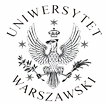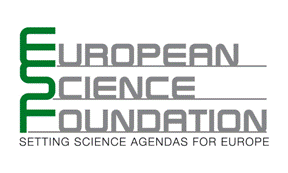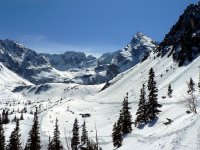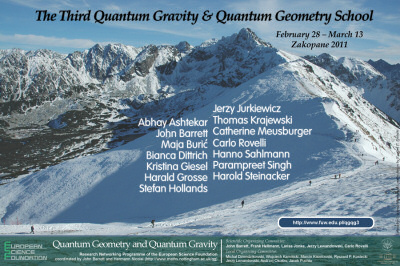 The aim of the School The aim of the School
The purpose of the school is to provide current PhD students, potdocs and
other researchers with an up-to-date introduction to the main research
topics of the network: loop quantum gravity, spin foam models, matrix
models, and the application of non-commutative geometry and quantum groups
to quantum gravity as well as more recent developments like group field
theory. The emphasize will be on progress made during the four years of the
ESF network program Quantum geometry and Quantum Gravity.
 Core lectures Core lectures
The heart of the program will be a series of core lectures by leading
researchers which will give students a solid introduction to the topics of
the school.
Abhay Ashtekar - Opening lecture (slides)
Hanno Sahlmann/Kristina Giesel - Loop quantum gravity (notes: 1, 2, 3, 4)
The field of loop quantum gravity is
the technically highest developed construction in quantum gravity. As in the
last two schools there will be a thorough introduction into the underlying
ideas and mathematical methods. The lectures will cover the basic
construction of the kinematical hilbert space and some simple operators,
working up to the dynamical Hilbert spaces and physical Hamiltonians
following from the deparametrization models.
Carlo Rovelli - Spin foams (lectures paper, lecture notes: 1, 2, 3, 4)
The most active field in the network in the last
years has been spin foam models, starting with the development of the
graviton propagator and the new models, to coherent state techniques and
recent asymptotic results, the generalisation to arbitrary 2-complexes and
cosmological applications. The lectures will present the current perspective
on the construction of these models in terms of 2-complexes.
Harold Steinacker - Non-commutative geometry and matrix models (slides: 1, 2)
Non-commutative geometry is a natural extension of geometry in the context
of quantum theories that potentially, may also include gravity.. NCG
naturally occurs in particle physics, as shown by Alain Connes, and also
appears naturally in the context of three-dimensional quantum gravity via
Chern-Simons theory. It is also used as a technical tool in state sum
models, particularly via quantum groups, which provide deformations of the
usual spin network calculus which can be used to construct quantum gravity
models. The lectures will cover the definition and construction of
non-commutative spaces as well as the construction of QFTs on them. Another
theme will be the relationship to matrix models.
Thomas Krajewski - Group field theories (lecture notes: 1, 2)
Recently group field theories, generalisations of
matrix models to higher dimensions, have received renewed attention. In the
last year work has begun to take them serious as quantum field theories and
analyse their properties using the tools of QFT. The lectures will cover the
general structure of GFTs and introduce the QFT tools used to study their
renormalisation theory.
Stefan Hollands - Exact QFT in curved backgrounds (lecture notes: 1, 2, 3, 4)
QFT on curved backgrounds
is the formulation of QFT which does not require the symmetries of Minkowski
or (Anti) de Sitter space times. From the mathematical point of view this is
the highest development of QFT. It is also an important intermediate step
beetwing the standard QFT and quantum gravity. As an approximation to
quantum gravity it supplies some of the most potent intuitions of the field
(holography, black hole entropy). The lecture will cover the recent results
and successes in the exact construction of these quantum field theories.
 Auxiliary lectures Auxiliary lectures
The lectures of the core program will be augmented by a set of smaller
lectures that either deepen a particular aspect of a subject introduced in
the core lectures or give brief introductions to related and relevant topics
and techniques. Rather than providing a deep technical introduction they
should show students further ideas to pursue and study.
Parampreet Singh - Loop quantum cosmology (lecture notes, plots)
Symmetry reduced models are one of the key areas of applications of loop
techniques in physically relevant contexts. Following the Core LQG course
these lectures will show how to apply these and related techniques in the
symmetry reduced sector of GR.
Winston Fairbairn - SqL(2,C) (lecture notes: 1, 2, 3)
Following the introduction on non-commutative spaces this lecture will
introduce the quantum deformation of the Lorentz group SqL(2,C). Quantum
deformations of SU(2) are a key area of application of non-commutative
geometry as a technical tool in quantum gravity models and SqL(2,C)
deformations are expected to play a similar role in the future.
Maja Burić/Harald Grosse - Renormalisation of the Grosse-Wulkenhaar model (lecture notes: 1, 2)
Following the core lectures on matrix models and field theories on non
commutative space time these lectures will cover the detailed analysis of
the Grosse-Wulkenhaar model. This theory is a nontrivial quantum field
theory on a non-commutative space time which is fully renormalisable.
Bianca Dittrich - Diffeomorphisms, renormalisation and perfect action in
discrete theories (lecture notes)
Spin foam models, when taken as discretisations of a continuum action,
require renormalisation to find a continuum limit. This lecture course will
introduce the notions of renormalisation and perfect actions in discrete
theories with special emphasize on the role of (the breaking of)
diffeomorphism invariance.
Jerzy Jurkiewicz - Causal dynamical triangulations (slides: 1, 2)
An alternative approach to the definition of the path integral of quantum
gravity is to sum not over geometric moduli of a fixed discretisation, but
instead to sum over all discretisations with fixed geometric building
blocks. This lecture will give an introductory overview of causal dynamical
triangulations, the most successful and sophisticated such technique.
 Planned individual talks Planned individual talks
- Claudio Perini - Graviton propagator
- Eugenio Bianchi - Friedmann equation from the EPRL vertex amplitude
- Wojciech Kamiński - EPRL map: SO(4) and SO(1,3), integrability (lecture notes)
- Johannes Brunnemann - Volume operator (notes, slides)
- Simone Speziale - LQG and twisted geometries (slides)
- Aristide Baratin - Geometric constructions of GFTs (lecture notes)
- Winston Fairbairn - SqL(2,C) EPRLK model (see lecture notes: 1, 2, 3)
 Schedule of lectures Schedule of lectures
| | 12-13 | 13-14 | 14-15 | 15-15:30 | 15:30-16:30 | 16:30-17:30 | 17:30-18 | 18-19 | 19-20 | | March 1 | lunch | Rovelli | Rovelli | tea break | Giesel | Giesel | coffee break | Sahlmann | Sahlmann | | March 2 | lunch | Giesel | Giesel | tea break | Sahlmann | Sahlmann | coffee break | Rovelli | Rovelli | | March 3 | lunch | Giesel | Sahlmann | tea break | Brunnemann | Brunnemann | coffee break | Rovelli | Rovelli | | March 4 | lunch | Rovelli | Rovelli | tea break | Krajewski | Krajewski | coffee break | Fairbairn | Fairbairn | | March 5 | lunch | Bianchi | Bianchi | tea break | Fairbairn | Fairbairn | coffee break | Krajewski | Krajewski | | March 6 | - | - | - | - | - | - | - | - | - | | March 7 | lunch | Perini | Perini | tea break | Speziale | Speziale | coffee break | Baratin | Baratin | | March 8 | lunch | Hollands | Hollands | tea break | Dittrich | Dittrich | coffee break | Singh | Singh | | March 9 | - | - | - | - | - | - | - | - | - | | March 10 | lunch | Singh | Singh | tea break | Steinacker | Steinacker | coffee break | Hollands | Hollands | | March 11 | lunch | Steinacker | Steinacker | tea break | Grosse | Grosse | coffee break | Hollands | Hollands | | March 12 | lunch | Steinacker | Steinacker | tea break | Burić | Burić | coffee break |
Hollands | - | | March 13 | lunch | Jurkiewicz | Jurkewicz | tea break | Kamiński | Kamiński | coffee break | - | - | | | | | | | | | | | | | | The opening lecture by Abhay Ashtekar will take place on March 1, at 11:00. | |
 Transport Transport
- The shuttle service from Car Polonia offers direct mini-bus transfers from Krakow Balice airport to Zakopane.
- There are buses from Kraków Główny train station to Zakopane every 30-40 min, the trip lasts 2 hours modulo trafic, the cost is about 17zł/4eu (see www.trans-frej.com.pl and www.szwagropol.eu)
- There are trains from Kraków Główny train station to Zakopane few times a day, the trip takes 3-4 hours, the cheapest version costs about 20zł/4,5eu, (see pkp), comfortable version costs about 34zł/8eu (see Intercity - from Kraków Główny to Zakopane).
- There is a train from Kraków Airport do Kraków Główny train station every 30 min, the trip takes 15 min and costs 8zł/2eu (see details - from Kraków Balice to Kraków Główny).
- There is a bus (175) from Warsaw Airport to Warsaw Central Station every 30 min, the trip takes 30 min, the cost is about 4zł/1eu (see details).
- There is a train from Warsaw Central Station (Warszawa Centralna) to Kraków Główny Station every 1-2 hours, the trip takes 3 hours - epsilon and costs about 100zł/24eu (see Intercity) or 5 hours + epsilon and costs about 50zł/12eu (see pkp).
- There is a direct train from Warszawa Centralna to Zakopane a few times a day, the trip takes 10 hours and costs about 60zł/14eu (see pkp) or ... (see Intercity).
 Organization Organization
|
The school is held within the framework
of the new ESF research network Quantum Geometry and Quantum Gravity, coordinated
by John Barrett and Hermann Nicolai - see http://www.maths.nottingham.ac.uk/qg
for further information about the network.
Patronage: Janusz Majcher, Major of Zakopane
|
|
| |
|
| John Barrett | Michał Dziendzikowski |
| Frank Hellmann | Wojciech Kamiński |
| Larisa Jonke | Marcin Kisielowski |
| Jerzy Lewandowski | Ryszard Kostecki |
| Carlo Rovelli | Jerzy Lewandowski |
| | Andrzej Okołów |
| | Jacek Puchta |
| | |
| | In case of questions write to Marcin Kisielowski. |
|  

|
 Registration & participants Registration & participants
- In order to register fill in the registration form. Note that the first day of the lectures is 1st of March, and the last day of lectures is 13th of March.
- If you have already registered and you want to check or change your data or cancel your registration, you have to log in.
- You can also take a look on the current list of registered participants.
- In case of any questions about registration - ask registration administrator.
 Lecture place, fees & accomodation Lecture place, fees & accomodation
School fee: 360PLN (~90EUR), covers the food and beverages during the lunch breaks (~22PLN/day) and two coffee breaks (~10PLN/day) for 11 days, paid upon the arrival to the hotel. (The precise value of the fee may slightly change.)
There are avaible special funds for US students and postdocts to participate in this school.
The lectures will take place at Hyrny guesthouse in Zakopane:
Dom Wczasowy Hyrny
ul. Piłsudskiego 20
Zakopane
tel/fax: +48 18 2015778
The participants of the school can arrange their accomodation in the following hotels:
- Hyrny - the conference venue (alternative reservation links: here and here)
- Rzemieślnik - next door (30-second walk)
- Carlton - nearby (3 minutes walk)
- Patria - nearby hotel (3 minutes walk)
- Litwor - nearby hotel (5 minutes walk)
 Localisation Localisation
 | Zakopane is a tourist and ski resourt in the Tatra Mountains in Poland.
During the school it will be also possible to ski, snowboard (down hill,
2000m - 1000 m) or walk in the national park. For more information about
Zakopane see Wikipedia, www.ezakopane.pl, Zakopane-life.pl and Zakopane.pl.
Ski rental: Montana - Ski Service (Hotel Bevedere, 5 minutes walk from Hyrny)
|
 Poster Poster

| Hi-res (3000x2000) version for print. (Note that this is standard RGB palette picture, so the CMYK palette printout might differ.) |
| 

